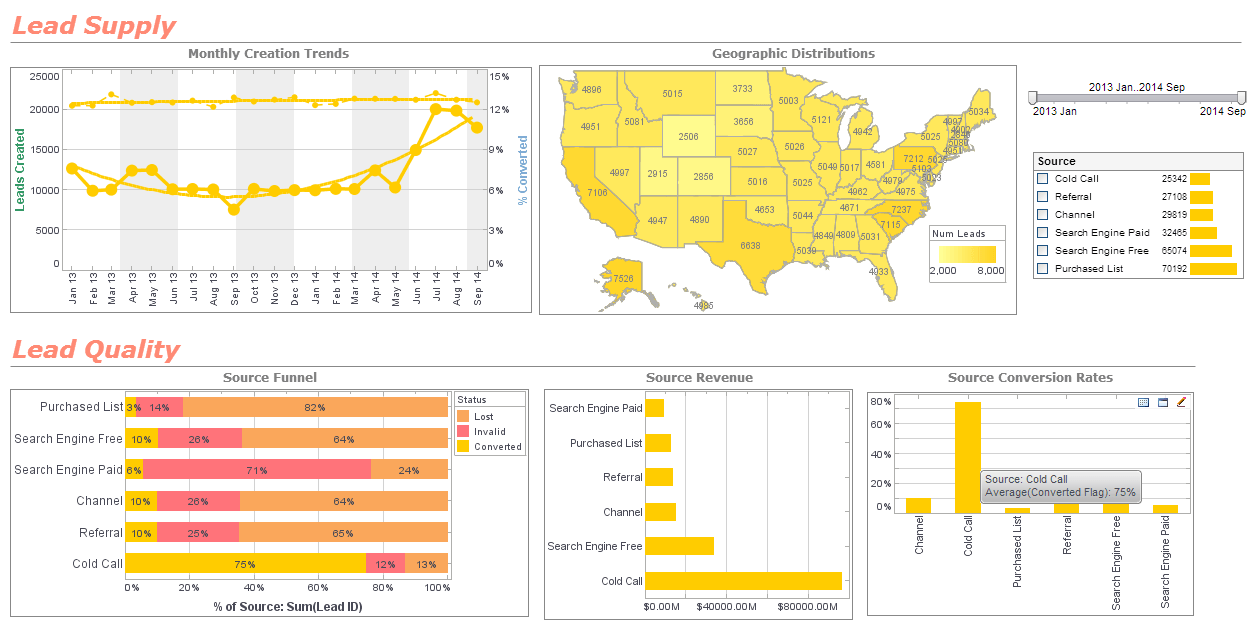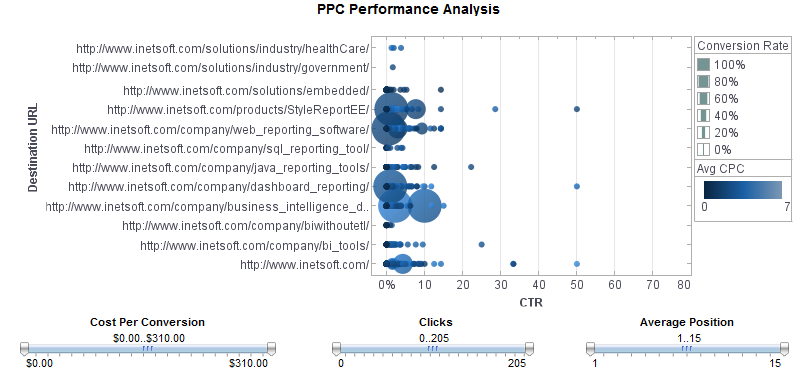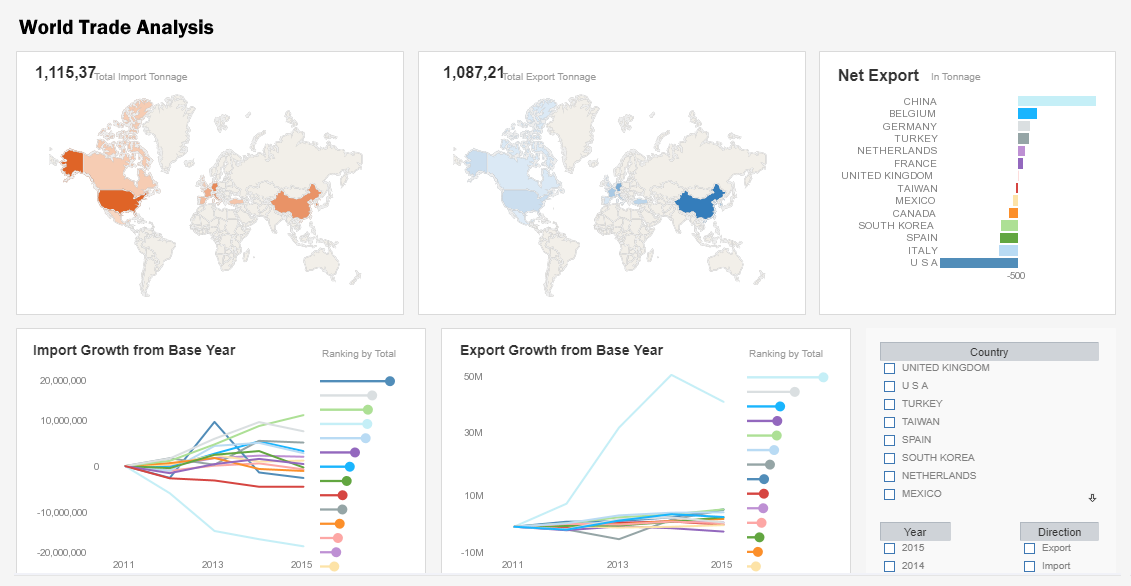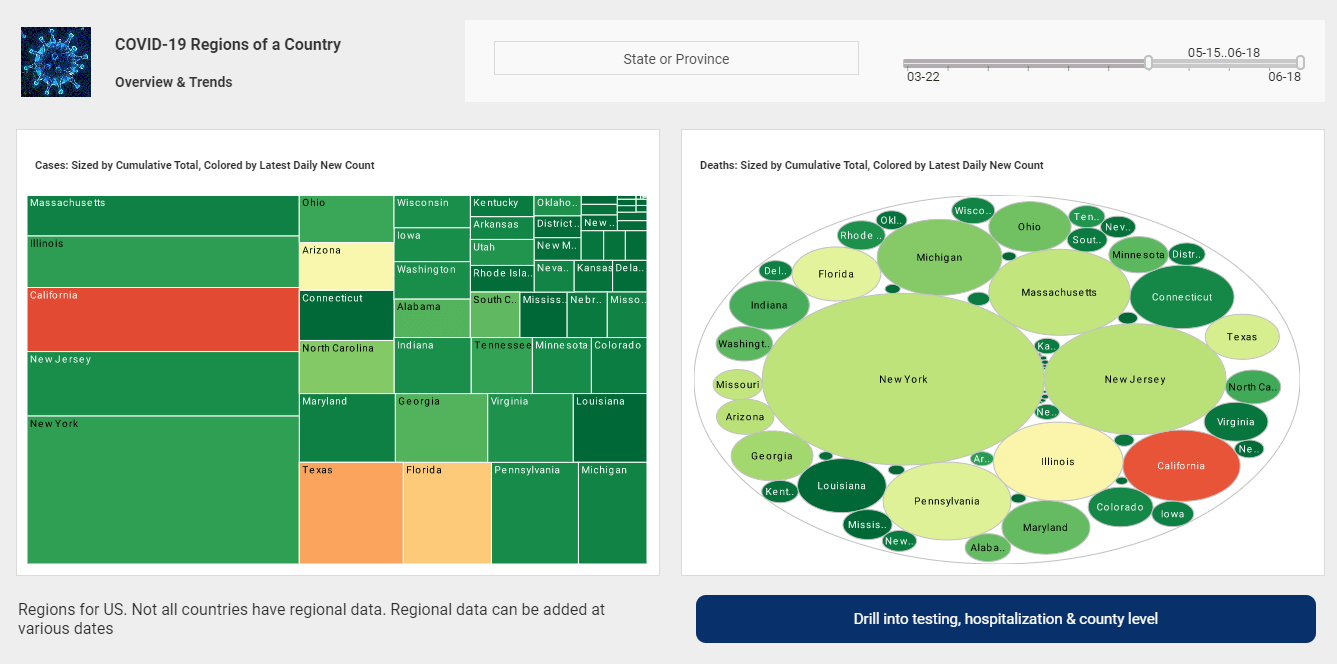What is the Definition of a Performance Management System?
A performance management system is an informational system that helps ensure that organizational goals are being met efficiently and effectively. The focus can range from organizational goals all the way down to individual employee performance on individual projects. A performance management system usually tracks key performance indicators (KPIs) through dashboards, reports, and scorecards.
Recently, performance management systems have been in use by more managers at many different levels of an organization. However, many of these systems were designed for technical users, and require IT help for customization.
Also, the consolidation of the performance management market over the last five years has made selecting a performance management system more complicated. Due to recent mergers and acquisitions, large vendors are now offering a confusing array of components that are cumbersome to assemble and configure. InetSoft offers a simpler solution.
StyleBI Makes Advanced Performance Management Simple
InetSoft's StyleBI gives end users with little technical background the ability to create customizable dashboards, reports, and scorecards for tracking KPIs.
Does your performance data come from multiple sources? InetSoft's patent-pending Data Block enables data to be mapped from multiple sources into a data integration environment that supports a spreadsheet-like user interface.
This interface enables interactive KPI dashboards to be built and customized by the end user. A standard calendar display simplifies selecting the desired time intervals for analysis and reporting.
In addition to dashboards, scorecards are also excellent for tracking dashboard metrics, centralizing all the KPIs into one easy reference. StyleBI enables the easy creation of balanced scorecards that compare current performance data against goals, quotas, and target trends, with simple color-coding for quick recognition. The scorecards can also be made to incorporate information on what action to take if specified goals are not met.
Customized alerts can also be set if KPIs reach or go below a certain threshold, ensuring that important developments do not go unnoticed. Delivery options include texting to mobile phones and emailing to all other devices.
About InetSoft
Since 1996 InetSoft has been delivering easy, agile, and robust business intelligence software that makes it possible for organizations and solution providers of all sizes to deploy or embed full-featured business intelligence solutions. Application highlights include visually-compelling and interactive dashboards that ensure greater end-user adoption plus pixel-perfect report generation, scheduling, and bursting.
InetSoft's patent pending Data Block technology enables productive reuse of queries and a unique capability for end-user defined data mashup. This capability combined with efficient information access enabled by InetSoft's visual analysis technologies allows maximum self-service that benefits the average business user, the IT administrator, and the developer. InetSoft solutions have been deployed at over 5,000 organizations worldwide, including 25% of Fortune 500 companies, spanning all types of industries.
 |
Read the top 10 reasons for selecting InetSoft as your BI partner. |
How Does a Quality Control Manager at a Steel Mill Use Performance Management Systems?
A Quality Control Manager at a steel mill plays a critical role in ensuring that the steel produced meets high-quality standards. Performance management systems are essential tools that help the manager monitor, assess, and improve the quality control processes.The most important step is setting quality objectives. The manager uses the performance management system to establish clear and specific quality objectives for the steel mill:
-
Reducing Defect Rates: Objective: Achieve a 10% reduction in the overall defect rate in steel products compared to the previous year.
-
Meeting Industry Standards: Objective: Ensure that 100% of steel products meet or exceed the quality standards set by relevant industry organizations (e.g., ASTM, ISO).
-
Improving Process Efficiency: Objective: Increase the efficiency of the steel production process by 15% through streamlined quality control procedures.
-
Enhancing Material Traceability: Objective: Implement a system to track and trace the source of raw materials used in steel production with 100% accuracy.
-
Minimizing Scrap and Waste: Objective: Reduce scrap and waste in the production process by 20% through improved quality control measures and process optimization.
-
Ensuring Consistency in Dimensions: Objective: Maintain a tolerance level of +/- 1% for critical dimensions in steel products across all batches.
-
Optimizing Testing and Inspection Processes: Objective: Decrease the time taken for quality testing and inspections by 25% without compromising accuracy or thoroughness.
-
Enhancing Customer Satisfaction: Objective: Achieve a customer satisfaction rating of 95% or higher based on feedback surveys related to product quality and reliability.
-
Compliance with Environmental Standards: Objective: Ensure that all quality control processes adhere to environmental regulations and sustainability initiatives.
-
Employee Training and Certification: Objective: Maintain a 100% certification rate for quality control personnel, ensuring they have up-to-date training and qualifications.
-
Reducing Non-Conforming Products: Objective: Decrease the number of non-conforming steel products by 15% through improved process controls and early defect detection.
-
Maintaining Regulatory Compliance: Objective: Ensure that the steel mill consistently meets all local, national, and international regulatory requirements related to quality and safety.
-
Implementing Continuous Improvement Initiatives: Objective: Facilitate at least one major process improvement project per quarter to enhance quality control procedures and outcomes.
-
Achieving Cost Efficiency: Objective: Reduce quality-related costs by 10% while maintaining or improving quality standards.
What are the KPIs Used by Steel Mills?
-
Production Volume: Measures the total amount of steel produced within a specific period, typically in tons or metric tonnes.
-
Capacity Utilization: Indicates the percentage of a steel mill's production capacity that is currently being used.
-
Yield Rate: Calculates the percentage of usable steel produced compared to the total amount of raw materials used.
-
Scrap Rate: Measures the percentage of unusable or waste material generated during the production process.
-
Energy Consumption per Ton of Steel: Evaluates the amount of energy (electricity, gas, etc.) consumed to produce one metric ton of steel.
-
Maintenance Downtime: Tracks the amount of time the mill is non-operational due to planned maintenance or unexpected breakdowns.
-
Safety Incidents and Lost Time Incidents (LTIs): Records the number of safety incidents and the amount of time lost due to accidents or injuries.
-
Quality Metrics (e.g., Defect Rate, Conformance Rate): Includes measures like the percentage of steel products meeting quality standards and the rate of defects identified.
-
Inventory Turnover: Indicates how quickly raw materials are used up in production, helping to optimize inventory levels.
-
Customer Satisfaction: Measures customer feedback and satisfaction levels related to product quality, delivery times, and service.
-
On-Time Delivery Rate: Tracks the percentage of orders delivered to customers on or before the agreed-upon delivery date.
-
Environmental Impact (e.g., CO2 emissions, waste disposal): Monitors the environmental footprint of the steel mill's operations.
-
Cost per Ton of Steel Produced: Evaluates the total cost incurred to produce one metric ton of steel, including materials, labor, and overhead.
-
Process Efficiency: Assesses how effectively resources are used in the production process, including labor, energy, and materials.
-
Customer Complaint Rate: Measures the frequency of customer complaints related to steel quality, delivery issues, or service.
-
Return on Investment (ROI): Calculates the financial return generated from investments in equipment, technology, and process improvements.
-
Employee Productivity and Utilization: Evaluates the efficiency and utilization of labor resources in the production process.
-
Supplier Performance: Assesses the performance of suppliers in terms of quality, timeliness, and reliability of raw material deliveries.
 |
Read how InetSoft was rated as a top BI vendor in G2 Crowd's user survey-based index. |
Resources for Students Learning About Performance Management System
5 Important FMCG Performance Indicators - 1. Cycle Time from Cash to Cash This helps you to examine and keep track of how long it takes to turn resources into cash flows. Three ratios, the days of inventory, plus the days of payables, as well as the days of receivables, are combined in this KPI. It stands for the time elapsed between when a company pays cash to vendors and when it gets cash from customers. It is helpful when determining... Catalog of Online Metrics Dashboard Examples - /products/metrics_dashboard_examples/ Online metrics dashboards are revolutionizing business, as they bring the benefits of metrics dashboards to users wherever they are. Now executives can monitor performance and predict trends when working from home, or even on their phone while they're taking the subway...
Chart Using Red-Yellow-Green - / The chart you see is just a way to look at a spreadsheet with red, yellow, green so you can kind of scan it and zero in on the numbers that you need to look at. This is much better than just having the numbers in there because then you have to look at the number and remember what the goal or the target is and so ...
Consider InetSoft's Dashboard Management System - Looking for a good dashboard management system? InetSoft, a pioneer in self-service oriented dashboard software offers an easy to setup system for creating interactive dashboards and analyses. Our customers rate our service as top performing on G2.com. Balanced scorecards can provide critical updates as often as possible, tracking as many parameters (e.g., sales revenue) as needed...
 |
View the gallery of examples of dashboards and visualizations. |
Difference Between The Presentation Layer Of Kpis And The Back-End - Let's talk about the difference between the presentation layer of KPIs and the back-end. There is a very tight relationship between performance management and master data management, meaning if you're defining the key metrics top to bottom that will help us perform better as a company, those metrics ...
How Scorecards Improve Business Performance - 1. Providing data from disparate sources into one comprehensive visualization - This enables management and employees to take the appropriate actions 2. Allowing goals to be clearly defined and easily conceived on screen - This ensures that all levels of the enterprise remain on the same page 3. Acting as a precise business tool to measure and predict business activities - Gauge the health of employees and business overall...
Example of a Client Scorecard - InetSoft's comprehensive real-time analytical reporting and dashboard software provides users with client scorecards that serve to monitor, measure, and manage performance by tracking metrics in real-time. View the example below to learn more about the StyleBI solution...
Good ServiceNow Dashboard Application - Are you looking for a good solution for ServiceNow dashboard reporting? InetSoft's pioneering BI application produces great-looking cloud-based dashboards with an easy-to-use drag-and-drop designer. This type reflect the success of each step in the service request lifecycle. For example, if you're tracking the number of requests submitted, the number of completed requests, and the average response time...
Improvement at the Operation Level - No matter what you tracking, what context it is, whether it's a warehouse or a factory, you start seeing improvement by the people are responsible for the job the operation level. They realize what they are doing has direct impact on that metric that they see displayed on the wall each day. It speaks to the internal competitive drive people have and how much they enjoy scorekeeping and seeing the results of their efforts...
 |
Learn about the top 10 features of embedded business intelligence. |
Information about Scorecards - Managers and business owners have a number of tools available to measure and manage their company's performance. One of the most effective and widely used tools is the balanced scorecard. Scorecards are customizable structured reports that compare actual performance figures (financial and non-financial...
Key Features of a Food Delivery Dashboard - KPIs are an effective way to present a consolidated view of the performance of an organization in a quantifiable format. InetSoft's Style Scope assists the designers in making the key food delivery metrics such as revenue and average customer review available to the business users, in large, easy to read text...
No Dedicated BI Developer Required - Unlike many other solutions that are so complex that one or more dedicated BI developers are necessary, InetSoft's technology has proven to require only fractional headcount. When deeper expertise needs do arise, InetSoft engineers are readily accessible on a one-on-one basis...
Option for Apache Superset Dashboards - Are you looking for a good alternative dashboard solution to Apache Superset InetSoft's pioneering dashboard reporting application produces great-looking web-based dashboards with an easy-to-use drag-and-drop designer. As a Java-based application, it delivers web-based dashboards and visuals...
Pain Point in Your Performance Tracking - This is sort of an eye opener for most folks when they go through it because a lot of times, they will put a lot of stuff over here, and then oh, my gosh, I never thought about this, or I really need organization values, and what's this pain thing I have never thought about that. That's always fun, folks, when you get into a workshop...
 |
Read how InetSoft saves money and resources with deployment flexibility. |
Real Time Performance Monitoring Dashboard Example in a Call Center - This dashboard refreshes every 5 seconds, feeding the user a constant stream of live data. This is the essence of real time, and this aggressive and powerful BI strategy is extremely useful for helpline, auto dispatch, customer service centers and more...
Third Pillar of Data Analytics: Performance - While talking about speed, it was completely about the physical performance of the machine and the model. But the third pillar of performance is about how effectively a model works in analyzing the data. Because not all businesses have structured data. Most of the data acquired comprise unstructured or semi-structured data which are difficult to bring under a single data analytic model...
Transportation Cost Analysis - The profitability of logistics operations is substantially impacted by transportation expenses. To monitor and reduce transportation costs, logistics operations analysts use a variety of analytics technologies. They assess variables such shipment costs, carrier performance, fuel costs, and method of delivery. Analysts may find chances to combine shipments, bargain better prices...
Unified Views of Financial Performance - With InetSoft, a unified view of your organization's financial performance can be described as: •Easy- Deployed in just weeks, learned by end users with minimal training, used by any executive without the aid of IT •Agile - Adaptable to changing data and business needs, used for data exploration through visualization, capable of maximum self-service •Robust - Attract the attention of executives, meet the demands of power users, scale up for organizations of any size...






